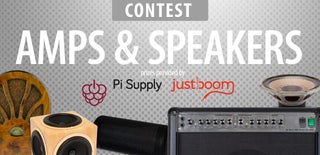Introduction: Elder Bluetooth Speaker
My goal for the Elder Bluetooth Speaker was a speaker that could fill a large room with full sound and look great doing it. In this build I'm using reclaimed redwood for the front baffle, which works well and sounds great, but you can use any aesthetically pleasing wood. I've found hardwoods sound the best. The enclosure is made from solid pine. I chose this for it's looks after being stained and because the font and back will have an exposed edge. You can use plywood for the enclosure, but you would want to edge band it.
This will be an overview of this build.
Get detailed plans with crossover and templates HERE
Step 1: The Guts & Stuff
This speaker is based around the Dayton Audio KAB-230 Bluetooth amplifier. 60 watts is plenty of power to fill a large living room with quality sound.
I would consider this an intermediate build. Some woodworking practice will help, but an ambitious newbie can pull off this build as well.
Materials Needed
Bluetooth Amp - https://goo.gl/nbQH0a
Cable Kit - https://goo.gl/gZwm37
Woofers x2 - https://goo.gl/TyzNA6
Tweeter - http://amzn.to/2e8VYGB
Back Plate - http://amzn.to/2e8VYGB
Port Tube x2 - http://amzn.to/2e8VYGB
Aux cable - http://amzn.to/2e8VYGB
Power Adapter - http://amzn.to/2e8VYGB
Knob - http://amzn.to/2e8VYGB
Power Connector - http://amzn.to/2e8VYGB
Switch - http://amzn.to/2e8VYGB
Ebony Stain - http://amzn.to/2fpg2B3
Finishing Oil - http://amzn.to/2fe7XhY
Pine Boards
Hardwood Boards
.5" Ply Wood
Tools Needed
Drill - http://amzn.to/2fEwU9x
Jig Saw - http://amzn.to/2fQMAGZ
Circular Saw - http://amzn.to/2eM3uSZ
or
Miter Saw - http://amzn.to/2feebhB
Straight Edge - http://amzn.to/2eCrA4V
Router - http://amzn.to/2eskH33
Router Table - http://amzn.to/2fuVdCN
3" Hole Saw Drill Bit - http://amzn.to/2fbi6ik
Forsner Bit Set - http://amzn.to/2fQItL5
Drill Bit Set - http://amzn.to/2eCu9Ea
Soldering Iron - http://amzn.to/2djSPjh
Glue Gun - http://amzn.to/2djSPjh
Center Punch - http://amzn.to/2djSPjh
Crossover
Step 2: The Box
Start with your pine boards. Set your miter saw or circular saw to a 45 degree angle and cut two 20" and two at 5.5". Make sure to cut both 45 degree ends inward. Next, set your table saw or circular saw at 7" and rip each board to 7"
Now it's time to cut the rabbet for the front and back baffle. I use a 1.25" mortising bit in a router and router table, but you can also make these cuts on a table saw. Cut the front rabbet at .75" and the back at .5". Cut it about a half inch deep. Make a few test cuts to be sure you have the correct depth.
Lay out each piece across a straight edge, and using painters tape, tape up each joint. Flip the piece over and glue each joint. Fold each piece until you've created a box. Glue and tape the last joint and there you go! You got a box!
Step 3: The Face
Measure the inside of the front opening of your box. Transfer those dimensions to your front baffle wood and cut it using your table saw, circular saw, or miter saw. Be sure to place the front baffle into the box for a test fit. Make adjustments as needed.
Mark out where you want the speakers to be and cut out the holes. I used a chamfer bit to cut a bevel into the inside of the speaker cutouts.
Make sure to test fit your speakers!
Step 4: The Back
Just like the front, measure the inside of the back of the box. Transfer those measurements to a piece of .5" ply wood and cut it out. Again, test fit the baffle to make sure it fits correctly.
Mark where you want the control plate and bass tubes to be placed and cut them out using a jig saw and drill.
Step 5: The Finishing
Sand both the box and the front baffle with 220 grit sand paper. You can go down to 320 grit if you'd like.
Finish the front baffle with finishing oil or clear spray paint. I stained my enclosure with ebony wood stain and finished it with matte clear spray paint.
Step 6: The Components
Place the woofers in their positions and mark the screw positions. Drill out the holes and use small screws to secure the the woofers to the inside of the front baffle. Take care to not drill through the front baffle and make sure your screws are short though not to poke through. Solder the speaker wires included in the kit to the speaker leads.
Get details on the crossover used HERE
Mark and drill the positions for your amp controls and LED indicators on the control plate. Add the controls and indicators to he plate, then add the plate to the back baffle.
Pop in the bass ports and your back is ready to go!
Step 7: The Finishing Bits
Run a bead of glue along the inside lip of the front of your box and press in your front baffle. Apply pressure to the piece for at least twenty seconds.
Drill and screw in the feet of your speaker.
Add dampening material to the inside walls of your enclosure, including as much as you can on the back baffle.
Solder your switch and power connector leads and connect them to the amp board. Connect all other connectors to the amp board. Find a location for your board and screw or hot glue it to the inside of the enclosure.
Place all the wires within the enclosure and screw in your back baffle. A little weather stripping is a good way to seal up the enclosure.
I have lots of other speaker building videos on my YouTube Channel if you want more!
Step 8: The Sound Test
Take a listen to how it sounds!
Thanks for watching!
-Kirby
Step 9: Detailed Plans
If you are looking for detailed plans, crossover components, and templets, check out my build plans HERE.
I aslo have Elder Bluetooth Speaker Build Kits available HERE.

Second Prize in the
Amps and Speakers Contest 2016

Participated in the
Glue Challenge 2016











